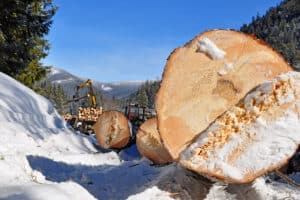Like Bob the Builder, forest finance analysts and timberland investors carry a toolkit to get the job done. The level of rigor of the tools and techniques we use increases as we get closer to making a bid or closing a transaction. However, in the preliminary stages, a quick assessment or back-of-the-envelope approach helps screen deals and save time so we can allocate resources to better understanding the best investment opportunities.
“Current Stand” Approach for Valuing Forestland
A reasonable estimate of a forest’s current economic value equals the standing merchantable volume multiplied by the current stumpage prices in the local market. Investors sometimes use this “back-of-the-envelope” technique to estimate the liquidation value of a timberland investment. However, this basic approach suffers from observable, value-destroying limitations. Why? It ignores the potential for generating greater wealth by holding the forest to economic maturity, investing in forest management, identifying other revenues, or accounting for taxes or opportunity costs associated with the land and capital.
Generally, the “current stand approach” is useful when talking about timberland investing while having a beer or standing over the hood of a truck, not when signing checks or allocating capital for long-term investing. However, in practice, the “current stand approach” can serve short-term investors looking to liquidate the asset upon purchase. If you’ve heard someone say “the forest paid for the land,” it’s likely they bought a forested property, harvested the trees and covered their entire acquisition price with revenues generated from selling those trees.
“Current Rotation” Approach for Valuing Timberland
The “current rotation” approach treats the value of a potential timberland investment as the net present value (NPV) of the first or current rotation. There are cases when this might be useful or interesting. For example, if estimates of future rotations generate incredible returns or cringe-worthy losses. In practice, the current rotation approach speaks to limitations we face when estimating future returns. Whether future forest rotations or investments prove wildly profitable or wasteful, we would expect investors and the market to respond. Either more investors will enter the asset class, which raises prices and reduces returns, or current investors exit the asset unless they can reduce costs or increase their revenues.
If you live by the “80/20 rule” for making decisions, a current rotation assessment could provide a guide for deciding whether or not further consideration of a given investment is useful. For example, the NPV of a 25-year rotation forest will capture approximately 70% of a complete bare land value (BLV). One final note: a requirement of applying the current rotation approach is the need to specify a terminal value. Often, we use the BLV as the estimate of selling the bare timberland at the end of the current rotation after harvest.
Final Thoughts
In the handbook Forest Finance Simplified, I discuss how these snapshot values have specific weaknesses. For example, current realizable values for the standing timber will be low at any given point in time. So a “current stand” valuation suffers from market timing. Also, for large timberland ownerships or plantations, the local market can rarely absorb a total liquidation (clear cut) of inventory without depressing local prices. However, these techniques help “get your head in the game” when thinking about which timberland opportunities may be preferable or actionable before moving forward with deeper analysis.
This content may not be used or reproduced in any manner whatsoever, in part or in whole, without written permission of LANDTHINK. Use of this content without permission is a violation of federal copyright law. The articles, posts, comments, opinions and information provided by LANDTHINK are for informational and research purposes only and DOES NOT substitute or coincide with the advice of an attorney, accountant, real estate broker or any other licensed real estate professional. LANDTHINK strongly advises visitors and readers to seek their own professional guidance and advice related to buying, investing in or selling real estate.










I think this is a great article, as it shines a light on what we look at when pricing tracts for Seller that want to be relevant to the market. It also brings up the fact that a Timberland Investment has immediate options for income, but could have a greater value if proper management and patience are used. Refer back to a professional with local market knowledge on land and timber values to help make the best decisions for each situation. Great Article.